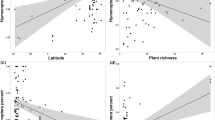Abstract.
Specialization of a plant on a particular pollinator may not evolve if co-pollinators are effective and abundant. This is particularly evident if fruit set is resource limited and cannot be increased above the levels produced by the actions of co-pollinators. The pollinating seed-consuming interaction between senita cacti and senita moths in the Sonoran Desert presents a paradox because it exhibits many traits resembling those of the highly specialized yucca/yucca moth system, but also involves co-pollinators. For 6 years, we studied how contributions of nocturnal senita moths and diurnal co-pollinating bees to fruit set depended on resource and pollen limitation, time of flower closing, and the onset and phenology of flowering. Fruit set was typically resource limited. Fruit set of flowers exposed only to senita moths was not different from resource-limited fruit set of control flowers. When only co-pollinating bees were allowed to visit flowers, however, fruit set became pollen limited. Only in one year when fruit set was pollen limited were bees able to increase fruit set beyond the level resulting from senita moth pollination. High temperatures commonly induced flowers to close before sunrise so that diurnal bees were unable to visit flowers. This was particularly important from 1998 to 2000, when flowering did not begin until late in spring when temperatures were already high enough to induce flowers to close before sunrise. Bees were typically functionally redundant with senita moths; excluding bees from visiting flowers did not alter fruit set. Nevertheless, extreme specialization of floral traits to exclude co-pollinators has not evolved in senita, possibly because there are times when bees do increase fruit set. This can occur when senita moths are rare, fruit set is pollen limited, cool temperatures prevent flowers from closing before sunrise, and flowering begins early in spring.
Similar content being viewed by others
Author information
Authors and Affiliations
Corresponding author
Additional information
Electronic Publication
Rights and permissions
About this article
Cite this article
Holland, N.J., Fleming, T.H. Co-pollinators and specialization in the pollinating seed-consumer mutualism between senita cacti and senita moths. Oecologia 133, 534–540 (2002). https://doi.org/10.1007/s00442-002-1061-y
Received:
Accepted:
Published:
Issue Date:
DOI: https://doi.org/10.1007/s00442-002-1061-y




